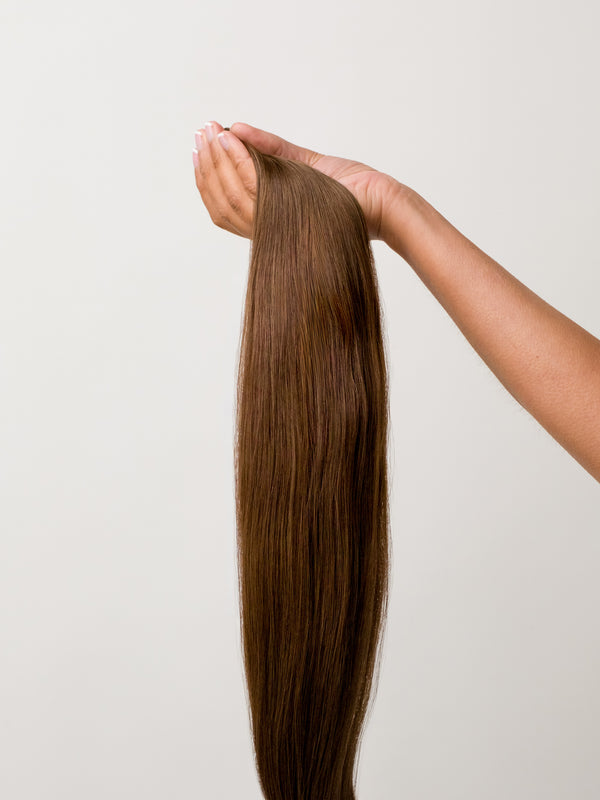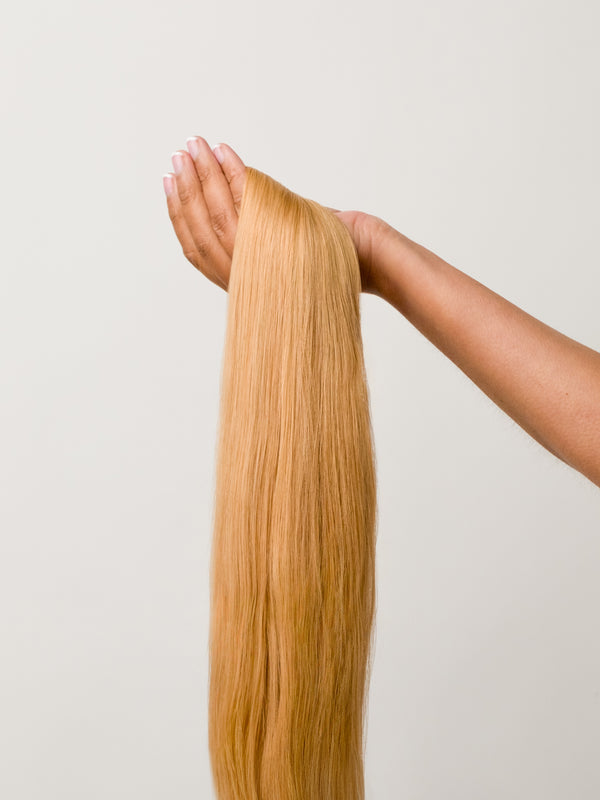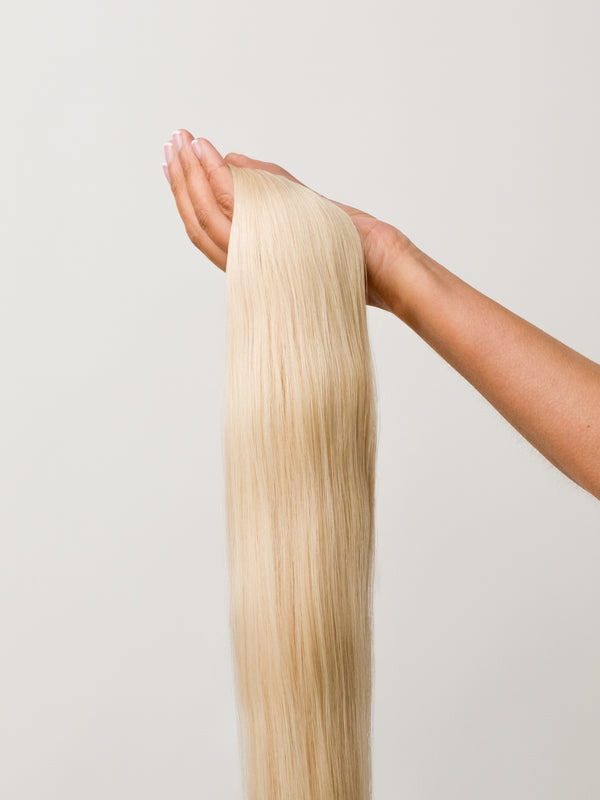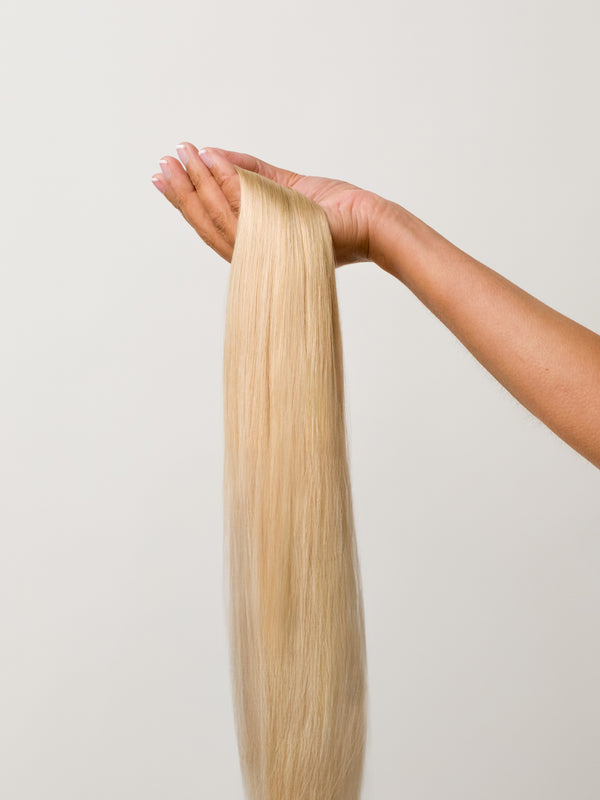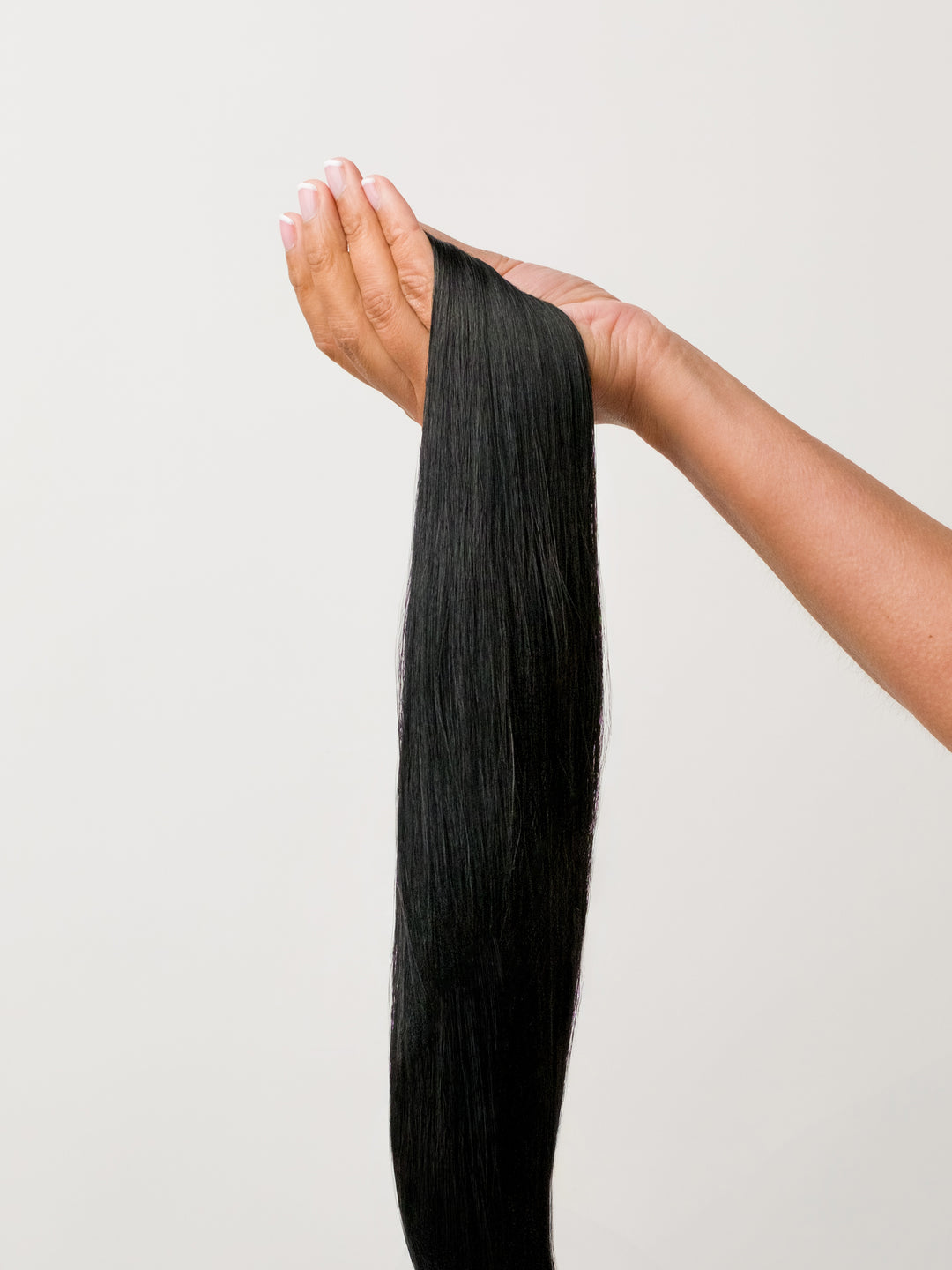If you’ve been dreaming of waking up to long, full, and flowing hair, then it’s time to consider hair extensions. With lots of different types of hair extensions and their methods available to your own hair at additional lengths, you may be unsure of where to start.
Hair extensions come in two main types:
-
Strand by strand: This includes bonded, micro links, and knotting.
-
Wefted panels: These are tape-in, clip-in, flip-in, sewn-in, and glued-in.
To help you make the best choice for your hair, check out our guide, which answers some FAQs and discusses the pros and cons of the best hair extensions and their proper maintenance.
Key Takeaways
-
Strand-by-strand extensions look super natural. You can make them look just how you want.
-
Fusion and strand-by-strand extensions cost a lot and take forever to install, but they last a long time.
-
Clip-ins are great for changing your hair just for a night out. You can easily take them out when you're done.
-
Tape-in extensions are pretty gentle on your hair, especially if you are dealing with hair breakage.
-
Take care of your extensions by brushing them often and not using oily products on them. This will help them last longer.
Strand-by-Strand Extensions
Strand-by-strand extensions, also known as individual extensions, involve attaching small sections of extension hair to your natural hair using various bonding methods. This technique is highly regarded for its natural look and versatility. The most common types of strand-by-strand extensions include keratin bonds or pre bonded hair extensions, micro-links, and nano-rings.

In the keratin bond method, small sections of your hair are bonded to the extension strands using keratin adhesive, which is then melted and sealed close to the root using a heating tool. Micro-links and nano-rings, on the other hand, use tiny metal beads or rings to secure the extensions to your natural hair, without the need for heat or glue.
Pros:
-
Natural movement: Since the extensions are applied in small sections, they mimic the natural movement of your hair, making them virtually undetectable.
-
Durability: With proper care, strand-by-strand extensions like pre bonded extensions can last between 16 to 20 weeks, making them one of the longest-lasting methods available.
-
Customization: This method allows for precise customization in terms of volume, length, and placement, making it ideal for those looking to achieve a specific look.
Cons:
-
Time-consuming application: Applying strand-by-strand extensions can take anywhere from 4 to 8 hours, depending on the number of strands and the desired look.
-
Potential discomfort: The attachment points can feel hard and uncomfortable, especially during the first few weeks after application.
-
Not reusable: Unlike some other extension methods, strand-by-strand extensions are not reusable especially when hair extension damage occurs. Once removed, you will need to purchase new hair for your next application.
-
Cost: This is one of the most expensive hair extension methods, with costs ranging from $600 to $3,500 or more, depending on the brand, number of strands, and location of the salon.
Best For:
-
Coarse, thick hair: The small, individual bonds work well with thicker hair types, as they can be easily concealed.
-
Long-term wearers: Ideal for those who want a long-lasting solution and are willing to invest the time and money.
-
Those seeking a natural, individualized look: The ability to apply the extensions in small sections allows for a highly customized result.
Maintenance Tips:
-
Avoid oil-based products: Oil can weaken the bonds, causing the extensions to slip or fall out. Stick to water-based or alcohol-based styling products.
-
Brush gently: Use a soft-bristle brush to detangle your hair, starting from the tips and working your way up to the roots. This will help prevent unnecessary strain on the bonds.
Weft Extensions
Weft extensions involve attaching wefts, or sections of hair sewn together at the top, to your natural hair. Weft extensions can be applied using various techniques, such as sewing (weaving), taping, or clipping. Hand tied weftmethod is popular for its versatility and ability to add both length and volume to your hair.

Tape-In Extensions
Tape extensions are one of the most popular and widely used weft extension methods. They consist of thin wefts with double-sided tape that is used to sandwich sections of your hair shaft between two wefts. This method is known for its quick application and natural-looking results.

Pros:
-
Quick application: Tape-in extensions can be applied in as little as 30 to 60 minutes, making them one of the fastest extension methods available.
-
Comfortable: The flat wefts lay close to the scalp, making them comfortable to wear and less likely to cause tension or discomfort.
-
Reusable: With proper care, tape ins can be reused for multiple applications, typically lasting 6 to 8 weeks per application.
-
Natural look: Tape-in extensions blend seamlessly with your normal hair, providing a natural and undetectable finish.
Cons:
-
Limited product use: Avoid oil-based products near the roots, as they can weaken the adhesive and cause the extensions to slip.
-
Not ideal for swimmers: Chlorine and salt water can affect the adhesive, reducing the longevity of the extensions.
Sew-In/Braided Extensions
Sew-in or braided extensions, commonly known as weaves, involve braiding the natural hair to create a base for the extensions, which are then sewn into the braids using a needle and thread. This method is particularly popular among individuals with coarse or thick hair.

Pros:
-
No heat or glue: The absence of heat and glue reduces the risk of damage to your natural hair.
-
Long-lasting: With proper care, sew-in extensions can last up to 2 to 3 months, making them a durable option.
-
Suitable for coarse hair: This method works well with thick, coarse hair, as the braids provide a strong foundation for the extensions.
Cons:
-
Tight braids: The tightness of the braids can cause discomfort and potential hair loss due to tension or traction alopecia.
-
Limited styling: The braids can limit your styling options, as certain styles may reveal the braided base.
Best For:
-
Thick, coarse hair: The braids used in sew-in extensions provide a sturdy base that works well with thicker hair types.
-
Individuals seeking a long-lasting solution: Sew-in extensions can last several months, making them a good option for those looking for a durable solution.
-
Those who prefer not to use adhesives or heat: This method is ideal for individuals who want to avoid the use of heat or glue during the application process.
Maintenance Tips:
-
Wash regularly: To prevent bacteria build-up, it's important to wash your hair regularly, especially the braided base.
-
Avoid over-styling: Excessive styling can cause the braids to loosen, reducing the longevity of the extensions.
Clip In Hair Extensions
Shop Roxy Hair
Clip-in extensions are a temporary solution for those who want to add length or volume to their hair without a long-term commitment. These extensions consist of wefts of hair with small pressure-sensitive clips that can be easily attached and removed by the wearer. Clip-in extensions from
Roxy Hair is perfect for special occasions or events where you want to change your hairstyle without a permanent alteration.
Pros:
-
Versatility: It offers the flexibility to change your hairstyle as often as you like. You can easily switch between different lengths, colors, and styles depending on your mood or the occasion.
-
Non-damaging: Since no heat, glue, or chemicals are involved in the application, clip-in extensions are one of the safest options for you and still promote natural hair growth.
-
Cost-effective: Clip-in extensions are relatively inexpensive compared to other methods, making them a great option for those on a budget.
Cons:
-
Temporary: Must be removed before bedtime to avoid damaging your natural hair or the extensions themselves.
-
Not ideal for fine hair: The clips can be bulky and may be visible if you have thin or fine hair, making them less suitable for those with this hair type.
-
Short lifespan: Unless cared for properly, clip-in extensions may only last a few months, especially if worn frequently.
Best For:
-
Occasional use: Clip-in extensions are perfect for those who want to enhance their hair for special events or occasions without a long-term commitment.
-
Beginners: If you're new to hair extensions, clip-ins are a great way to experiment with different styles before committing to a more permanent method.
-
Those looking for a non-committal option: Clip-in extensions can be easily removed whenever you like, offering maximum flexibility.
Maintenance Tips:
-
Wash only when necessary: Over-washing can cause the extensions to become dry and lose their luster. Use a deep conditioner if the hair becomes dry or dull.
-
Store properly: After each use, brush the extensions and store them in a dark place to prevent fading and tangling.
Fusion Bond Extensions
Fusion hair extensions involve bonding individual strands of extension hair to your natural hair using a keratin-based adhesive. The adhesive is melted and sealed close to the root using a heating tool (hot fusion) or an ultrasonic tool (cold fusion). This method is known for its long-lasting results and natural appearance.

Pros:
-
Long-lasting: Fusion extensions can last up to 4 to 6 months with proper care, making them one of the most durable extension methods available.
-
Customizable: The individual application allows for a highly personalized look, with the ability to add volume, length, or color exactly where you want it.
-
Seamless blend: The keratin bonds are discreet and blend seamlessly with your natural hair, providing a natural and undetectable finish.
Cons:
-
Time-intensive: The application process can take up to 8 hours, depending on the number of strands and the desired look.
-
Potential damage: The use of heat styling and adhesive can cause damage to your natural hair, particularly if not applied or removed correctly.
-
Not reusable: Fusion extensions cannot be reused once removed, so new hair must be purchased for each application.
-
Cost: Fusion extensions are one of the more expensive methods, with prices ranging from $600 to $3,500 or more, depending on the brand, the number of strands, and the location of the salon.
Best For:
-
Thick or coarse hair: Fusion extensions work best on thicker hair types, as the keratin bonds can be easily concealed.
-
Long-term wearers: Ideal for those who want a long-lasting solution and are willing to invest the time and money.
-
Those seeking a highly natural look: Fusion extensions offer one of the most natural-looking finishes, with discreet bonds that blend seamlessly with your natural hair.
Maintenance Tips:
-
Avoid oil-based products: Oil can weaken the keratin bonds, causing the extensions to slip or fall out.
-
Regular brushing: Use a soft-bristle brush to detangle your hair, starting from the tips and working your way up to the roots. This will help prevent unnecessary strain on the bonds.
Micro-Ring Extensions
Micro rings, also known as micro-link or I-tip extensions, involve attaching small sections of extension hair using tiny rings or beads that are clamped onto your natural hair. This method is popular for its durability and the fact that it does not require heat or glue.

Pros:
-
No heat or glue: The absence of heat and glue makes this method gentler on your natural hair, reducing the risk of damage.
-
Reusable: Micro-ring extensions can be adjusted and reused, making them a cost-effective option in the long run.
-
Natural movement: The individual strands move naturally with your hair, providing a realistic and undetectable finish.
Cons:
-
Visible beads: If not applied correctly, the beads can be visible through your natural hair, particularly if you have fine or thin hair.
-
Not ideal for fine hair: The weight of the beads can cause strain on thin hair, leading to discomfort or even hair loss.
-
Time-consuming: The application process can take anywhere from 2 to 5 hours, depending on the number of strands and the desired look.
Best For:
-
Medium to thick hair: Micro-ring extensions work best on medium to thick hair types, where the beads can be easily concealed.
-
Long-term wearers: Ideal for those who want a durable, long-lasting solution.
-
Those looking for a reusable option: The ability to adjust and reuse the extensions makes this method cost-effective in the long run.
Maintenance Tips:
-
Avoid oil-based products: Oil can cause the beads to slip, leading to the extensions falling out.
-
Regularly check and adjust: Visit your stylist regularly to check and adjust the beads, ensuring they remain secure and undetectable.
Summary
Choosing the right hair extension method depends on a variety of factors, including your hair type, lifestyle, budget, and how often you plan to wear them. Whether you're looking for a temporary change or a long-term solution, this guide should help you narrow down your options. Always consult with a professional stylist to ensure the best results and minimize the risk of damage to your natural hair.
Investing in the right method will not only enhance your appearance but also boost your confidence, allowing you to enjoy the benefits of beautiful, voluminous hair without compromising the health of your natural locks.
Frequently Asked Questions (FAQs)
1. Which hair extension method is the least damaging to natural hair?
Tape-in hair extensions because they spread weight evenly and don't need heat or harsh chemicals.
2. Can I color or dye my hair extensions?
Most human hair extensions can be colored or dyed, but it's recommended to have this done by a professional stylist.
3. How long do hair extensions last?
The lifespan of hair extensions varies depending on the method and how well they are maintained. Clip-in extensions typically last a few months with regular use, while strand-by-strand and fusion extensions can last up to 4-6 months with proper care.
4. Can I style my hair extensions with heat tools?
Yes, most human hair extensions can handle heat tools. Just make sure to use heat protectant and don't overdo it.
5. How often should I wash my hair extensions?
Hair extensions should be washed only every 1-2 weeks, depending on the product build-up and styling products used.






